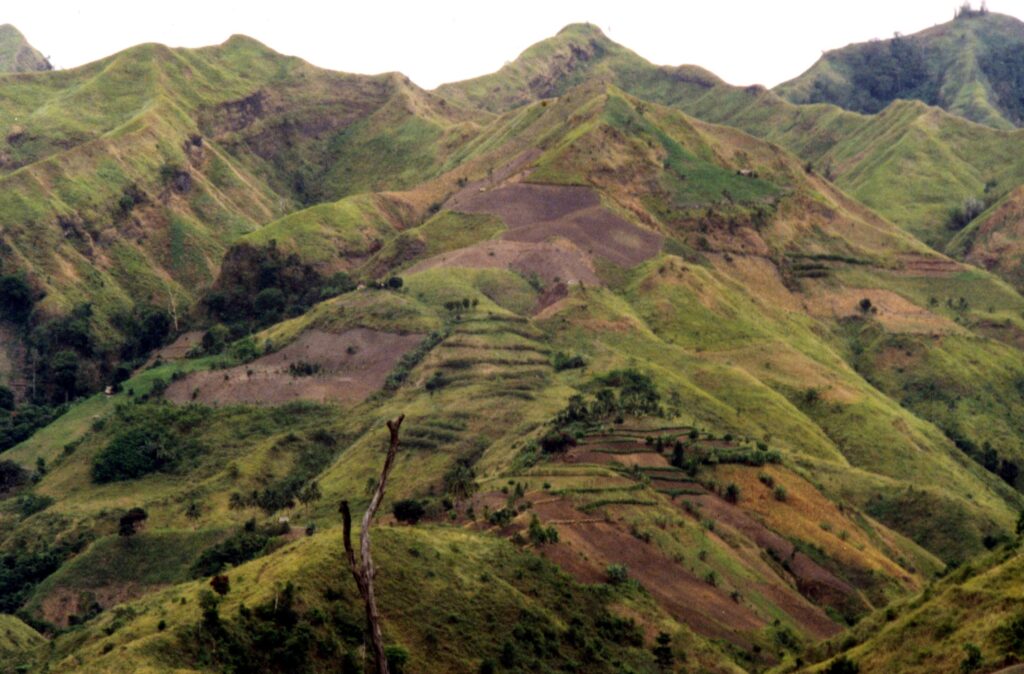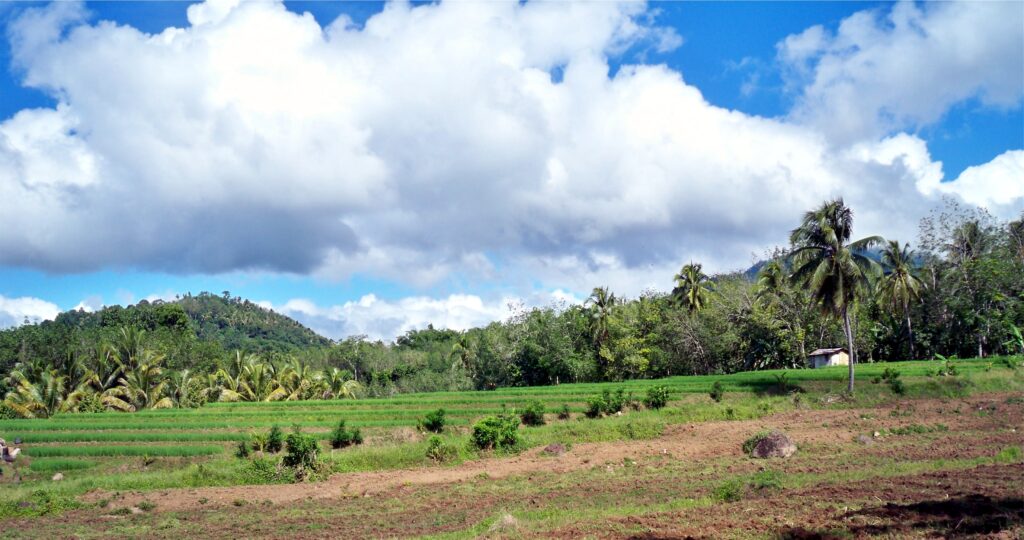Text and Photos by Henrylito D. Tacio
“The uplands are fragile areas, and when they get overloaded, they just can’t take it. Some people move and get trapped into something worse – urban slums, squatting, prostitution, drugs, you name it.” – Jon Jeffrey Palmer, former director of the Mindanao Baptist Rural Life Center
***

Geographically, the Philippines is an upland country because 60% of its 30 million hectares are classified as such. The uplands are rolling to steep areas where both agriculture and forestry are practiced on slopes ranging 18% upward.
Uplands also include tablelands and plateaus lying at higher elevations not normally suited to wet rice unless some form of terracing and groundwater existed.
The upland provinces include Benguet, Mountain Province, Ifugao, Kalinga-Apayao, Antique, Eastern and Northern Samar, Southern Leyte, Basilan, Agusan del Norte and Sur, Bukidnon, Surigao del Sur, Davao Oriental, Compostela Valley, Davao Occidental, and Zamboanga del Sur.
Uplanders – which comprised about 30% of the country’s total population with almost half of them living within forests – are often referred to as the “poorest of the poor” in the Philippine society since they survive below the poverty line.
Upland inhabitants are primarily poor farming families with insecure land tenure. “The upland farmer faces a very dark future unless something can be done for him soon,” says Roy C. Alimoane, the director of the Mindanao Baptist Rural Life Center (MBRLC) in Kinuskusan, Bansalan, Davao del Sur.
The upland farmer, Alimoane, believes, is “the least educated, least paid, least healthy, least hopeful, and most neglected (in terms of) agricultural development of all people in the Philippines.”

With recent attempts at industrialization, most uplanders are pushed farther to more fragile areas. A study commissioned by the National Research Council Project – entitled “Agricultural Sustainability and the Environment in the Humid Tropics” – found out that subsistence food production, rather than forestry, is their over-riding priority.
It’s no wonder why “most of the country’s once rich forests are gone,” according to the UN Food and Agriculture Organization’s (FAO) study entitled, “Sustainable Forest Management.”
“We have lost most of our forest of old over the past 50 years and, along with them, many of the ecological services they provide,” deplores Peter Walpole, executive director of the Environmental Science for Social Change (ESSC).
The once-upon-a-time forested areas, when cultivated by uplanders, become fragile. The steep slopes, loose soil, and torrential rainfall all the more make the uplands susceptible to landslides, mudflows, debris torrents, and other forms of soil mass movements, experts claim.
“The effects of population pressure on upland resources is magnified because of the high growth rate and intense poverty,” said Ma. Victoria O. Espaldon, who used to be with the Institute of Environmental Science and Management at the University of the Philippines at Los Baños.
Lack of income and livelihood opportunities stimulates people to migrate from the lowlands to inhospitable upland areas, which were mostly teemed with forests in the past. Those lowland migrants cut the trees extensively and adopted the unsustainable farming technologies they were noted for.
Denuded forest lands are believed to experience 100 tons of soil loss per year against less than eight tons per year from natural forests. The Philippines has nine million hectares classified as eroded soil.
Some years back, the Department of Environment and Natural Resources (DENR) said in 13 provinces, more than 50% of the total land area was eroded. Soil loss ranges from 50 to 300 tons per hectare per year. These rates signify five times the maximum soil loss levels for any type of soil.
“Soil erosion is an enemy to any nation – far worse than any external enemy coming into a country and conquering it because it’s an enemy you cannot see vividly,” said Harold R. Watson, former MBRLC director, when he received the Ramon Magsaysay Award for peace and international understanding in 1985. “It’s a slow creeping enemy that soon possesses the land.”
Watson said that soil erosion would imperil the country’s food supply in the coming years. “Land is not being remade,” he averred. “Soil is made by God and put here for man to use, not for one generation but forever.”
According to the American missionary, “it takes thousands of years to build one inch of topsoil but only one good strong rain to remove one inch from unprotected soil on the slopes of mountain.”

Most studies show that the eroded soil finds its way into the waterways, and 20% of the eroded ends up silting or contaminating rivers, coral reefs, and mangrove swamps.
“Many of us who live and work among the hilly land farmers and upland tribal groups in Asia are sounding the alarm to the problems of deforestation and soil erosion,” Watson said. “I call on people everywhere to help stem the tide of this wave of destruction while there is still time.”
Watson got the Nobel Prize of Asia for encouraging international utilization of Sloping Agricultural Land Technology (SALT), which he and his Filipino counterparts developed at the foothills of Mount Apo.
“The principle of SALT is the same as that used by the Ifugao tribes,” said Alimoane. “All we are doing is using trees and shrubs instead of rocks.”
SALT is a packaging technology on soil conservation and food production, integrating different soil conservation measures in one setting.
Basically, SALT is a method of the growing field and permanent crops in 3-meter to 5-meter wide bands between contoured rows of nitrogen-fixing trees and shrubs (NFTS) like “Flemingia macrophylla,” “Desmodium rensonii,” “Indigofera anil,” and “Leucaena leucocephala.” All are introduced species, except the latter, which is known locally as “ipil-ipil.”
“The NFTS are thickly planted in double rows to make hedgerows,” Alimoane explains. “When a hedge is 1.5 to 2 meters tall, it is cut down to about 40 centimeters and the cuttings are placed in alleyways to serve as organic fertilizers to crops.”

SALT is actually a diversified farming system practiced in one hectare. Rows of permanent crops like coffee, cacao, citrus, and other small-growing fruit trees are dispersed throughout the farm plot.
The strips not occupied by permanent crops are planted alternately to cereals (corn, upland rice, sorghum, etc.) or other crops (sweet potato, melon, pineapple, etc.) and legumes (soybean, mung bean, peanut, etc.). This cyclical cropping provides the farmer harvest throughout the year.
“Crop rotation helps to preserve the regenerative properties of the soil and avoid the problems of infertility typical of traditional agricultural practices,” Alimoane says.
In a speech delivered upon receiving his Ramon Magsaysay Award, Watson pointed out: “When a nation loses the capability to feed, clothe, and shelter itself, it loses the capability to chart its own destiny.”
Today – and not in the distant future – that the country’s uplands should be saved from total destruction. “The upland (area) is the ecological and social frontier where the battle for (the) future survival of the Filipino society will be fought,” Dr. Percy E. Sajise, of the University of the Philippines at Los Baños, said at that time.
“We must help fight this battle not because of any ideology or creed but primarily because we must assure the survival of the coming generation of Filipinos,” pointed out Dr. Sajise, whose pioneering work and contribution in the field of ecology are considered a breakthrough in providing solutions to pressing environmental problems.
“Let us not assign this responsibility to future generations or look around for somebody whom we should blame… when we ourselves can do something about it,” he urged.

